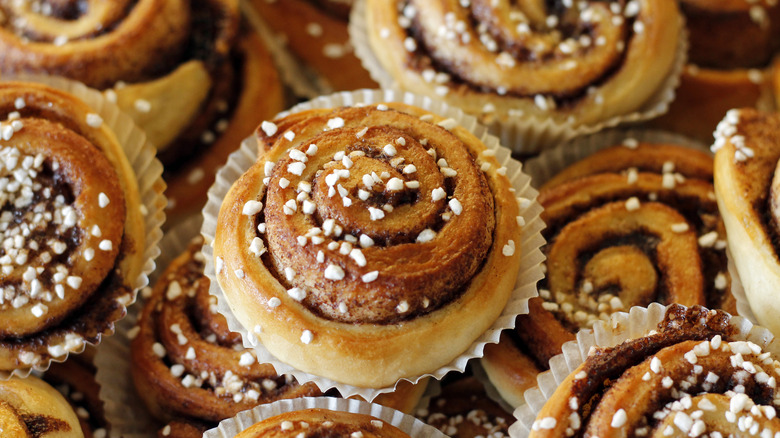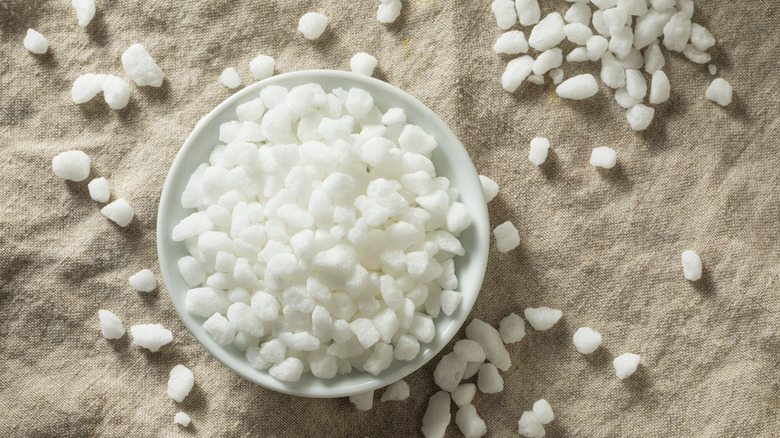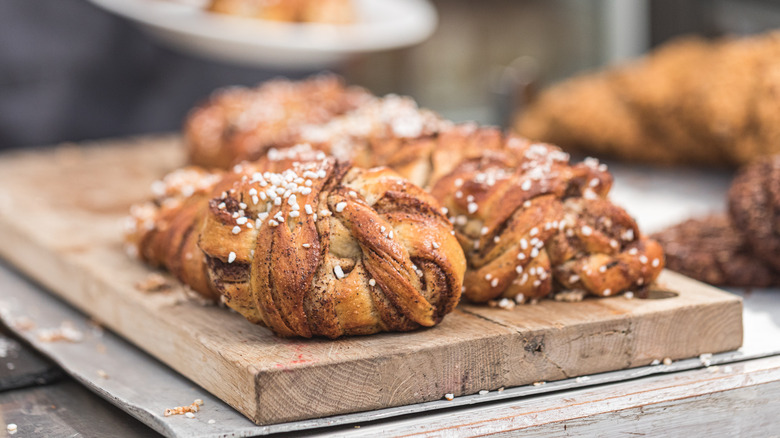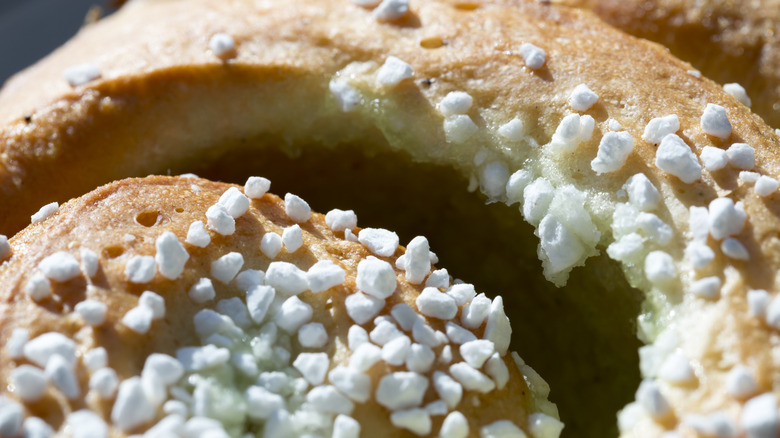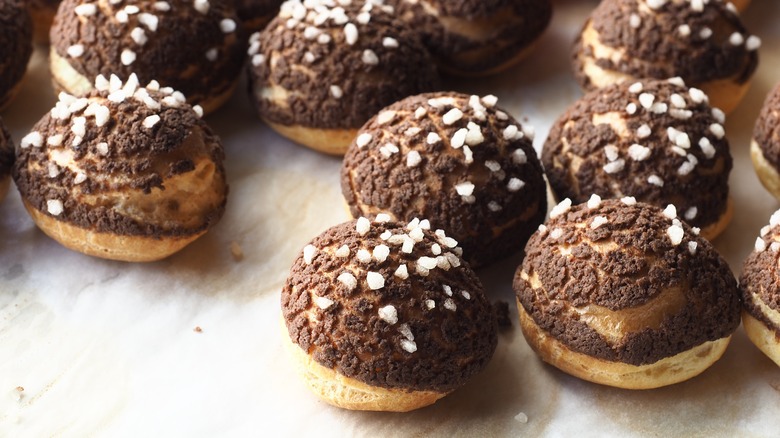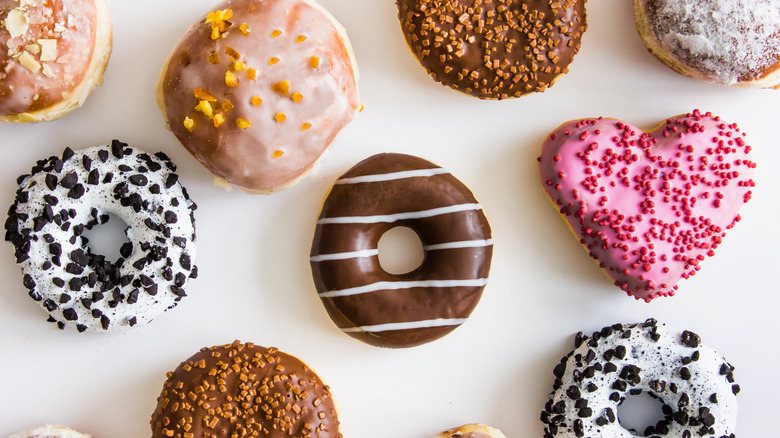What Makes Swedish Pearl Sugar Unique?
If you haven't heard of pearl sugar, you're not alone. Pearl sugar is most commonly found in bakery and pastry items in Europe. Also called nib sugar or hail sugar, these small white clumps of sweet deliciousness make the perfect finishing texture for Sunday morning cinnamon buns or a homemade batch of buttermilk Belgian waffles.
If you have tasted sweet Belgian Liège waffles, you may have tried in vain to replicate the tempting recipe. With a soft inside and a crunchy exterior, the secret is yeast, The Kitchen Whisperer explains, plus a two-step proofing process — and the addition of Swedish pearl sugar. Pearl sugar ultimately makes breakfasts exceptional by bringing a touch of caramelization and crunch to the fluffy batch of waffles you won't be able to forget.
Though finding pearl sugar in American grocery stores can be difficult, we have a few tricks to help you replicate this irresistible sugary crunchiness at home.
What is pearl sugar?
PureWow describes pearl sugar as the "Instaworthy finishing touch your baking needs," as this simple addition can elevate common bakery items to something a professional might produce. Pearl sugar is similar to refined white sugar, and you won't notice anything too different except for the texture, notes Spiceography, but that texture can pack a big punch when it comes to perfecting a cinnamon rolls recipe or making chocolate brioche.
Pearl sugar comes in two varieties: Belgian and Swedish (via Waffle Panty). While both Belgian and Swedish pearl sugars can decorate pastries, the Belgian variety is slightly larger and denser; it is used mainly for Belgian waffles (Cooks Illustrated). In contrast, the comparatively smaller Swedish pearls are mostly used as a finishing garnish (per Waffle Panty).
Pearl sugar can be made with beet sugar instead of cane sugar, delivering a subtle aftertaste that carries a more grounded flavor profile. According to NordGen, the sugar beet has long been the best option for sugar production in this more temperate part of the world and is often included in Nordic cuisine. Though cane sugar and beet sugar are similar, the beet variety doesn't caramelize as quickly as cane sugar and is crunchier in texture (per Healthline).
How to make pearl sugar
Pearl sugar can be difficult to find if you're not in Europe, and the ingredient can be pricey when purchased from specialty stores; Baker Betty simply takes sugar cubes and smashes them into pieces of the desired size. To add a sweet crunch to your baking recipes, MasterClass suggests cooking sugar and water over low heat until clumps form; or let sugar and maple syrup dry, then break the hardened mixture into pieces for the topping your baked goods deserve.
Milk and Pop reminds at-home cooks to use low heat, so the sugar doesn't caramelize. They recommend using filtered water, vanilla, and caster sugar to make your pearl sugar improvisation. We realize it might not be realistic to whip up a fresh batch of pearl sugar each time you want to top waffles or cinnamon rolls, so once you've made your own supply of sugar pearls, you can store your creation in a cool, dry container to preserve freshness.
How to buy pearl sugar
Determined to find and use the real deal in your recipes? Check labels carefully. As mentioned, Belgian and Swedish sugar nibs may appear similar at first glance, but depending on your baking needs, you'll want to pay attention. If you can't seem to find either variety online or on supermarket shelves, ask for nib or hail sugar, recommends Suedzucker; depending on your recipe — whether you're looking to make candies, add an extra crunch to a peppermint ice cream recipe, top biscuits, or sprinkle sugar pearls onto freshly baked bread — sugar pearls can be ordered in sizes ranging from just over one millimeter to 16 millimeters.
You can buy over 55 pounds of pearl sugar for around $70, according to Ampi, and many specialty stores sell pearl sugar in 10-ounce packages. Delighted Cooking suggests checking cake decorating shops or even visiting a nearby IKEA store to get your hands on varieties that have been imported directly from Sweden.
Using pearl sugar in recipes
Making pastries and baked goods with pearl sugar will not only be more attractive (the sugar will stay white and unmelted, even throughout baking), but the crunchy sweetness will have guests reaching for more (per Suedzucker). And if you do happen to use pearl sugar varieties made with beet sugar, you may notice earthy undertones, especially in creations like our red velvet beet cake recipe.
Confusing pearl sugar with sugar pearls is a common mistake, Cully's Kitchen warns, but they are two different kinds of sugar ingredients: one being a decorative orb meant for cookies and cupcakes and the other being the rougher, less-than-perfect shape that will make treats satisfyingly textured and crunchy. Be sure not to confuse any other type of sugar when mixing recipes at home; those soft cookies you had in mind may unintentionally come out of the oven with an added bite.
The difference between pearl sugar and sugar pearls
Whether you're decorating sugar cookies or hoping to present a ginger cake recipe with an extra sweet crunch, choose your sugar toppings wisely. Sugar pearl sprinkles are meant to decorate cookies and cupcakes while adding a colorful touch to baked goods. You can find these decorations placed on top of treats meant for celebrations and more festive affairs: think weddings, birthdays, anniversaries, and holidays. These sprinkles can be shiny or glazed and often appear on cakes, cupcakes, cookies, and even doughnuts.
As you now know, pearl sugar is rougher, crunchier, and is never perfectly round, and the jagged edges of pearl sugar give a satisfying crunch to bread and pastries. Colorful sugar sprinkle decorations may require an artful, more intentional placement, but the inclusion of pearl sugar can be a bit more haphazard. If you're looking to up your baked goods game, pearl sugar is an easy way to do it.
